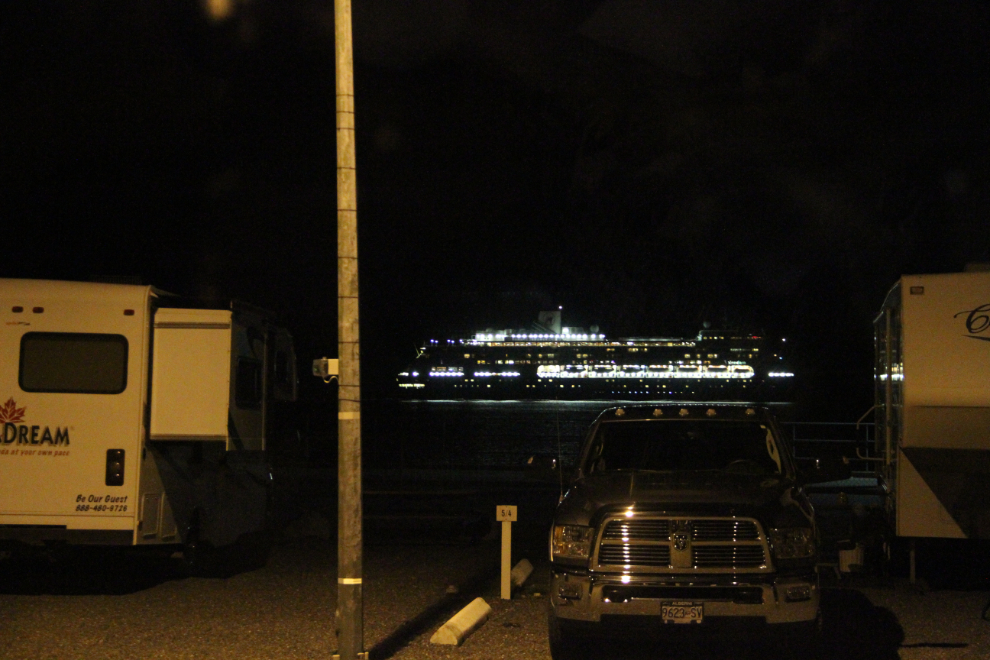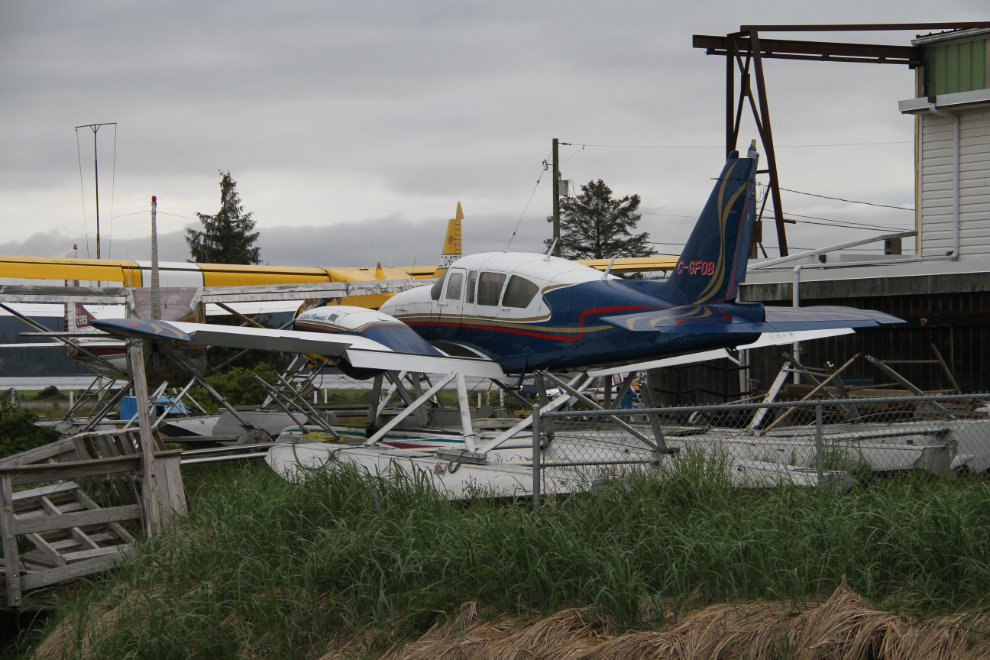Exploring Campbell River, BC
On Days 21 and 22 of the trip, May 16 and 17, we continued our look around Campbell River, which we had taken an immediate liking to.
On the way out to Elk Falls Provincial Park, I had noticed that we passed by Haig-Brown Heritage House, and we stopped in for a look on the way back to Campbell River. The farmhouse, built in 1923, was the home of Roderick Haig-Brown, a conservationist and writer whose work I knew well as a child.

I found a map of the property that showed walking trails around the property, but it wasn’t clear that there was any interpretation on the property, or for that matter, that the public was welcome, so we didn’t stay. It’s a lovely piece of property, though, and now that I’ve found the house’s Web site, I’ll go back if I get a chance.

I’m going to start our look at the City of Campbell River by giving you what I think is some significant background to the Campbell River that we see today. The next photo shows the long-abandoned Wei Wai Kum cruise ship terminal, which cost $18 million to build and opened in 2007. Campbell River managed to attract 10 ships in 2007 and 2008, but only 1 in 2009, and there don’t appear to have been any large ships since. The Campbell River Cruise Ship Schedule (now gone) is the only one I’ve seen that lists the ships that can simply be seen passing by. It takes a wide range of attractions to keep thousands of cruise ship passengers happy, and I expect that Campbell River was simply never able to create those. The countless millions that were spent on other facilities that were primarily aimed at the cruise passengers have certainly helped create a beautiful city for the rest of us, though.

We started our tour at Discovery Pier. Canada’s first salt water fishing pier extends 150 feet from the shore, and is 600 feet long.

With lots of benches, as well as built-in rod holders, bait stands, fish cleaning tables, a covered area with glass wind shields, and picnic tables, I imagine that this is a very popular spot in the summer.

We spent quite a while on the pier, just enjoying the sunshine and watching boats go by. There were also a few bald eagles, and there’s always the chance of a pod or orcas. This is one of Cathy’s happy places 🙂

A BC Ferry shuttles back and forth from Campbell River to Quathiaski Cove on Quadra Island about once an hour. The crossing only takes 10 minutes, and costs $45.35 plus taxes return for a car and 2 people.

Our next stop was the Maritime Heritage Centre, located at the foot of Discovery Pier. Admission is only $8 for adults, $5 for seniors. The star of this excellent little museum is the Motor Vessel B.C.P. 45, which was built for BC Packers in 1927. She is one of the oldest and the best-preserved of the wooden seiners that have survived in Canada.

We lucked in and got a tour of B.C.P. 45. No guides were scheduled to be on duty that day, but one was showing his family around and invited us to join them. He had spent his life on the water and the tour was extremely interesting.

B.C.P. 45 was the fishing boat seen on the $5 bill that was in circulation from 1972 until 1986.

The museum’s collection of diving equipment of all sorts is extensive, and a timeline of underwater exploration development is very interesting. This photo showes a submarine escape helmet. A container of sodium peroxide in it gave off oxygen while absorbing carbon dioxide. While they worked well, subs quit carrying them because they were too bulky.

The marine firefighting and rescue displays show some dramatic events. The caption on a series of photos showing a grounded freighter says: “Star Philippines. This ship tried to push Vancouver Island to Japan. It was unsuccessful.” 🙂

The collection of models is worthy of note. The quality of many is extremely high.

On April 5, 1958, a navigation hazard known as Ripple Rock was destroyed by the world’s largest non-atomic blast. It was located in Seymour Narrows just north of Campbell River, and photos and/or mentions of it are seen in many places around town, including the Maritime Heritage Centre.

This is the pedestal and wheel from the first HMCS Yukon (DDE 263). She was a Mackenzie-class destroyer which was launched on July 27, 1961, and decommissioned on December 3, 1993.

When the opportunity presents, I share photos with various databases. Nauticapedia had no photo of the Inlet Tempest, a tug built in Port Alberni in in 2015, so I’ve sent them this one to add to their listing.

After leaving the museum, we returned to the motorhome and went for a walk. We spent a long time on the beach on the spit at Dick Murphy Park, playing with Bella and Tucker, and just watching the boats going by. This is quite a popular park at all hours of the day. Even at dawn there are people walking dogs and just sitting, reading or watching the water.

This glorious sunset was captured from the beach in front of our RV park at 9:09 pm.

There was one cruise ship scheduled to pass by, and we decided to stay up and wait for it. We used MarineTraffic.com to watch her progress, and at 10:48, Holland America’s Voldendam sailed by. It was a good excuse to stay up later than usual and drink an extra glass of wine 🙂

There were a few things that wanted to get photos of the next morning, so I was out walking just before 07:00. The first destination was the float plane base just up the road on Tyee Spit. A heritage sign says that the Campbell River float plane base was the busiest in the world in the 1970s. It’s very quiet now, but there are some interesting planes. This DHC-2 Beaver, now registered as N600AX, was first delivered to the Government of Colombia on June 10, 1955. After working in Colombia for 42 years and accumulating 34,000 hours, she came to Canada in 1997. Owned by Sealand Aviation of Campbell River, she is now the test bed for a new aircraft engine, the Orenda TRACE, and with “Experimental” on the pilot’s door, she made her first flight in Texas in 2012. She should be an interesting plane to follow the progress of.

The other plane of particular interest was this 1969 Piper PA-23-250 Aztec, registration C-GFOB. This is not a plane that’s seen on floats very often. It’s called an Aztec Nomad when converted this way.

The Tyee Club, formed in 1924, is a unique Campbell River entity for fisherpeople. A heritage sign says: “club rules dictate that fish be caught from a boat that is being rowed or paddled. The gear, a single hook (barbless since 1998) attached to an artificial lure and 20 lb. test line, represents a significant handicap when your quarry is a Spring (Chinook) salmon weighing over 30 pounds!”

My next stop on the walk was the nearest of Campbell River’s harbours, which has an endless supply of interesting boats, most of them built for fishing. The first to catch my eye was the 44-foot Numas Isle, which was built in 1927 as the Ha-Wha-Las. Nauticapedia has more information about it.

The powerful-looking 82-foot seiner Western King takes fishing to a different level.

On the way back to the RV park at 08:00, the First Nations cemetery with its many magnificent carvings was irresistible.

Today, we would head even further north, to the famous though tiny port of Telegraph Cove.
